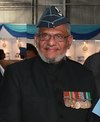Inventor
Ghouse Syed

The “FFWEC+" is a concept wave energy converter (WEC), developed from a series of inventions, namely (a) the "Free Floating Wave Energy Converter” (FFWEC), (b) "An Improved Free Floating Wave Energy Converter" (IFFWEC) and (c) “A Free Floating Wave Energy Converter having Variable Buoyancy Flexible Pipe and Enhanced Capture Width’. The FFWEC is the original invention, while the other two are improvement patents,
Not only is the FFWEC+ the only wave energy converter of its kind today, but it also indicates a potential to pump electricity, directly into the grid, at a COE of ~$ 0.02 to $ 0.03, per kWh - on MW scale.
The FFWEC was conceptualised about 10 years ago (in May - June 2005), as a solution to the challenge being faced by the state-of the-art Wave Energy Converters (WECs), mainly the every high Cost of Energy (CoE) and survivability in the oceanic environment, particularly during storms.
Feasibility trials conducted on the FFWEC, at the Dept. of Ocean Eng., IIT (M), were partially successful. The new inventions have improved features for overcoming the inadequacies observed during the trials.
The Device. The FFWEC+ essentially consists of the following sub-systems:
(i) Inlet,
(ii) Flexible Pipe (FP),
(iii) Air-Water Slug Timing and Control System (the only moving component per system),
(iv) Enhanced Buoyancy and Capture Width Device (EBCD) attached onto the FP,
(v) Air-Water-Separator (AWS) attached in fluid communication with the outlet of the FP, viz. in further fluid communication with a Pressure Chamber and a
(vi) Hydro Turbine-Generator (preferably, shore based).
Wave Farm. A few FFWEC+ devices could be grouped to make a wave farm, covering a large wave front.
How it Works: The Inlet and FP float on ocean surface, adapting to the wave form. The inlet doses air-water slugs into the FP which get pushed forward by transverse waves, progressively building up pressure in the FP to drive conventional Hydro-genes, which could be shore-based, pumping electricity directly into the grid.
Not only is the FFWEC+ the only wave energy converter of its kind today, but it also indicates a potential to pump electricity, directly into the grid, at a COE of ~$ 0.02 to $ 0.03, per kWh - on MW scale.
The FFWEC was conceptualised about 10 years ago (in May - June 2005), as a solution to the challenge being faced by the state-of the-art Wave Energy Converters (WECs), mainly the every high Cost of Energy (CoE) and survivability in the oceanic environment, particularly during storms.
Feasibility trials conducted on the FFWEC, at the Dept. of Ocean Eng., IIT (M), were partially successful. The new inventions have improved features for overcoming the inadequacies observed during the trials.
The Device. The FFWEC+ essentially consists of the following sub-systems:
(i) Inlet,
(ii) Flexible Pipe (FP),
(iii) Air-Water Slug Timing and Control System (the only moving component per system),
(iv) Enhanced Buoyancy and Capture Width Device (EBCD) attached onto the FP,
(v) Air-Water-Separator (AWS) attached in fluid communication with the outlet of the FP, viz. in further fluid communication with a Pressure Chamber and a
(vi) Hydro Turbine-Generator (preferably, shore based).
Wave Farm. A few FFWEC+ devices could be grouped to make a wave farm, covering a large wave front.
How it Works: The Inlet and FP float on ocean surface, adapting to the wave form. The inlet doses air-water slugs into the FP which get pushed forward by transverse waves, progressively building up pressure in the FP to drive conventional Hydro-genes, which could be shore-based, pumping electricity directly into the grid.
